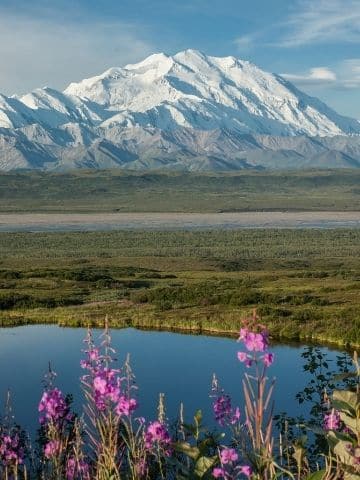
35+ Extraordinary Denali Facts & Statistics
- Jennifer Melroy
- Last Modified June 18, 2022
- First Published on October 9, 2021
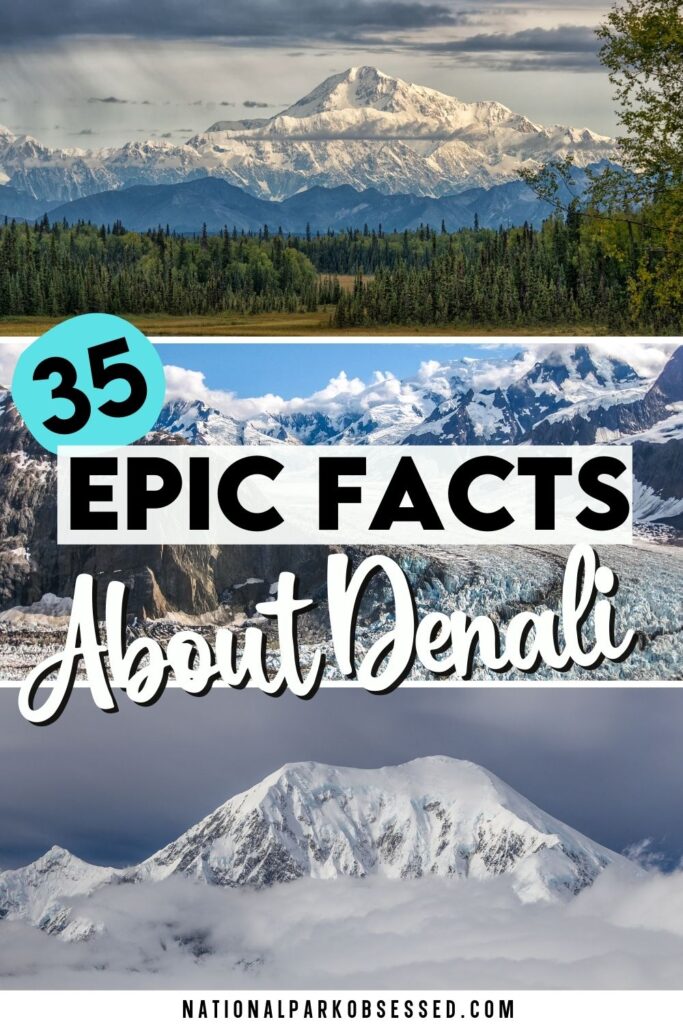


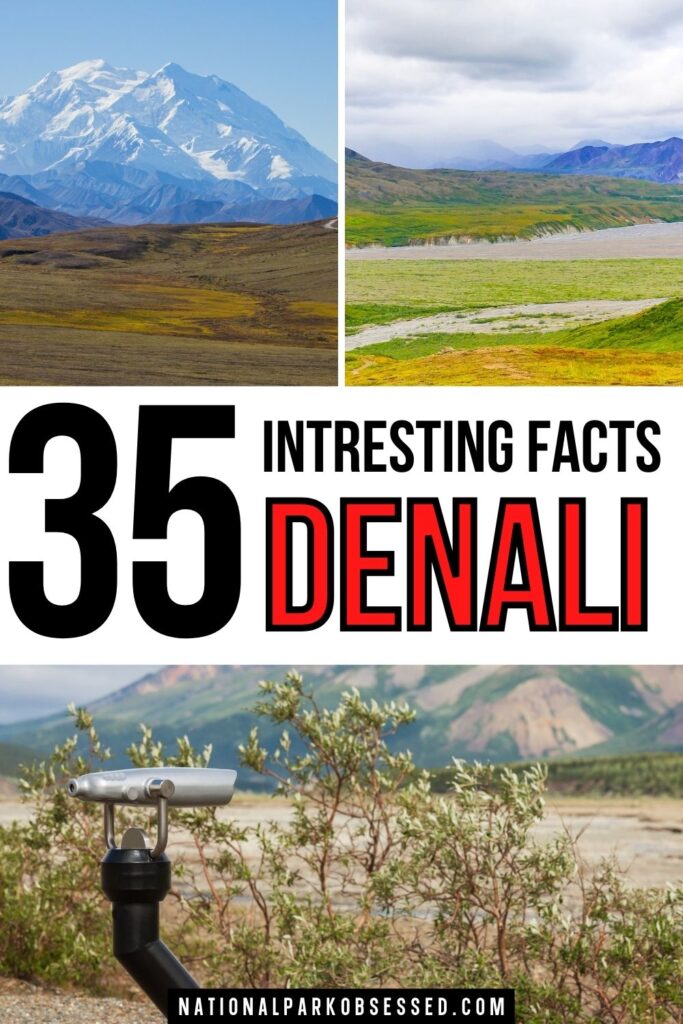

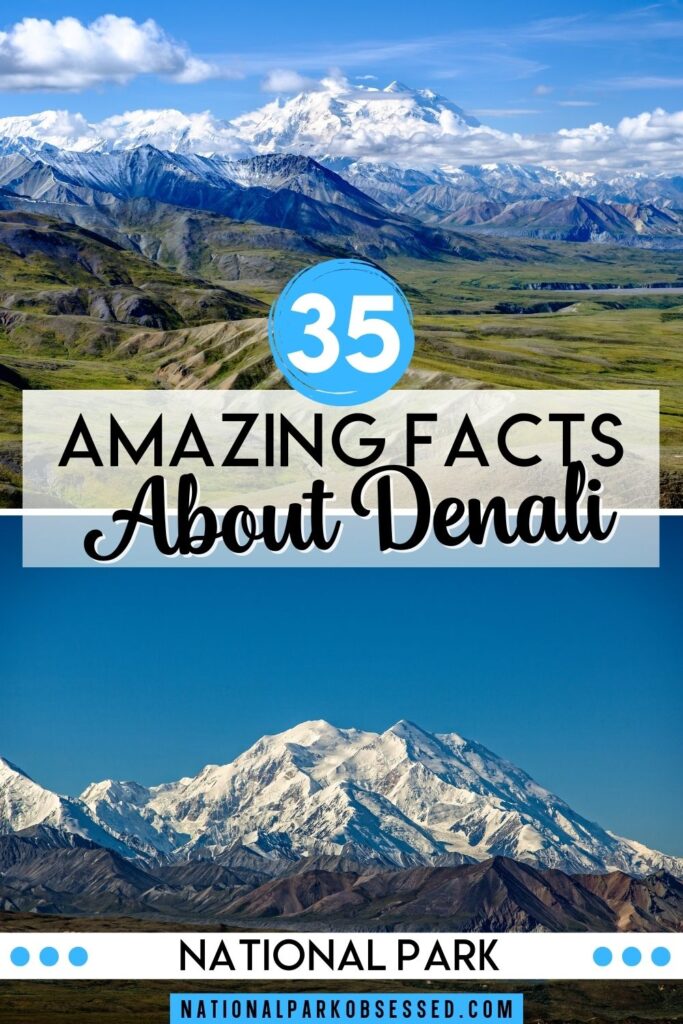

Post Summary: Denali Facts
Standing proudly in interior Alaska, one mountain stands above the rest. To locals, the mountain has always been known by her Athabaskan name “Denali.” To those living outside of Alaska, the mountain used to be called Mount McKinley. Denali means “The High One” and she is certainly a high mountain and seeing the mountain is on many people’s Alaskan bucket list.
If you are looking to learn more about Denali and Denali National Park, you are in the right spot. I have compiled some of my favorite Denali facts and statistics to help you prepare for your Denali trip.
Update of the 2022 Summer Season in Denali – Due to the Pretty Rocks Landslide, the Denali Park road will be closed at Mile 43. This means that all park services past mile 43 (Eielson Visitor Center, Igloo Campground, Wonder Lake) will be closed. Additionally, the 2022 Denali Road Lottery is canceled. All Transit Buses and Tour Buses are limited to mile 43.
Best of Denali National Park and Preserve in a Nutshell
THINGS TO KNOW: 11 Things to Know Before Visiting Denali National Park and Preserve
FACTS: 35+ Extraordinary Denali Facts & Statistics
BOOKS TO READ: 8 Books to Read Before visiting Denali National Park
GETTING THERE: How to Get to Denali National Park
HIKES: Best Hikes in Denali
TOURS: Best Tours in Denali
SPECIAL EVENTS: Denali Road Lottery
CAMPING: Camping in Denali
LODGING: Best Denali Hotels
NEARBY PARKS: Gates of the Arctic, Kenai Fjords, Kobuk Valley, Wrangell – St. Elias
Best of Denali National Park and Preserve in a Nutshell
THINGS TO KNOW: 11 Things to Know Before Visiting Denali National Park and Preserve
FACTS: 35+ Extraordinary Denali Facts & Statistics
BOOKS TO READ: 8 Books to Read Before visiting Denali National Park
GETTING THERE: How to Get to Denali National Park
HIKES: Best Hikes in Denali
TOURS: Best Tours in Denali
SPECIAL EVENTS: Denali Road Lottery
CAMPING: Camping in Denali
LODGING: Best Denali Hotels
NEARBY PARKS: Gates of the Arctic, Kenai Fjords, Kobuk Valley, Wrangell – St. Elias
This post may contain affiliate links, meaning if you book or buy something through one of these links, I may earn a small commission at no extra cost to you! Read the full disclosure policy here

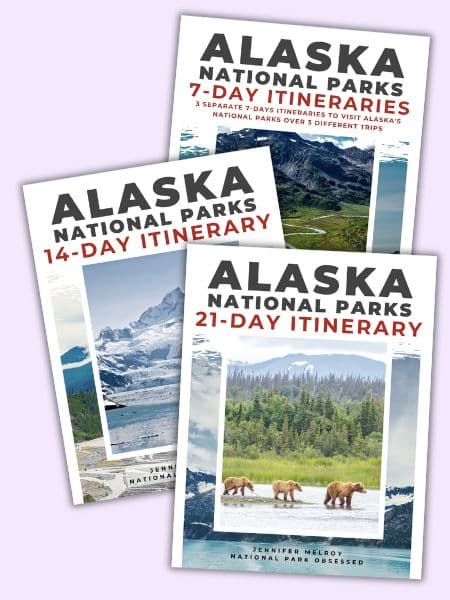
Does Alaska Trip Planning Leave You Feeling Overwhelmed?
Jump right into booking your Alaska National Parks trip with our expertly designed, pre-made, downloadable National Park itineraries.
Denali Geography Facts
There are some really interesting Denali statistics and records that make Denali a unique mountain.
- Denali is the highest mountain in North America (and the United States)
- Denali is 20,310 ft (6,190 m) above sea level. This new measurement was made in 2015 using GPS data. This is 10 ft. shorter than the 1953 height of 20,320 ft as calculated by Bradford Washburn, an American explorer, mountaineer, photographer, and cartographer.
- Denali is still growing. The mountain grows somewhere between 0.02 – 0.04 in. (0.5 – 1 mm) a year due to the Pacific Plate being forced underneath the North American Plate.
- Denali is the third-tallest mountain of the “Seven Summits” (the highest mountain on each continent) after Asia’s Mount Everest and South America’s Mount Aconcagua.
- Denali is the tallest mountain on land. Denali is 18,000 ft (5,500 m) from base to summit rise. Mount Everest is situated on the Tibetan Plateau and has a base to summit rise of 13,650 ft (4,160 m). (Mauna Kea of the Big Island of Hawaii is the largest moutain measured from ocean floor to summit. It rises 33,476 ft (10,204 m).)
- Denali has two summits. The South Summit is 1,270 ft (387 m) higher than the north summit.
- Denali has a topographical prominence of 20,194 ft (6,155 m). Topographical prominence is the vertical distance between the summit and the lowest point on the highest ridge connecting the mountain to another mountain.
- Denali has topographic isolation of 4,621 miles (7,437 km). Topographic isolation is the distance between the peak and a point of equal elevation. Denali’s closed point of equal elevation is Yanamax in Xinjiang, China.
- With its massive prominence, Denali is visitable for almost 200 miles and can be seen from Anchorage (130 miles) and Fairbanks (150 miles).
- The first recorded sighting of Denali by a European was on George Vancouver on May 6, 1794.
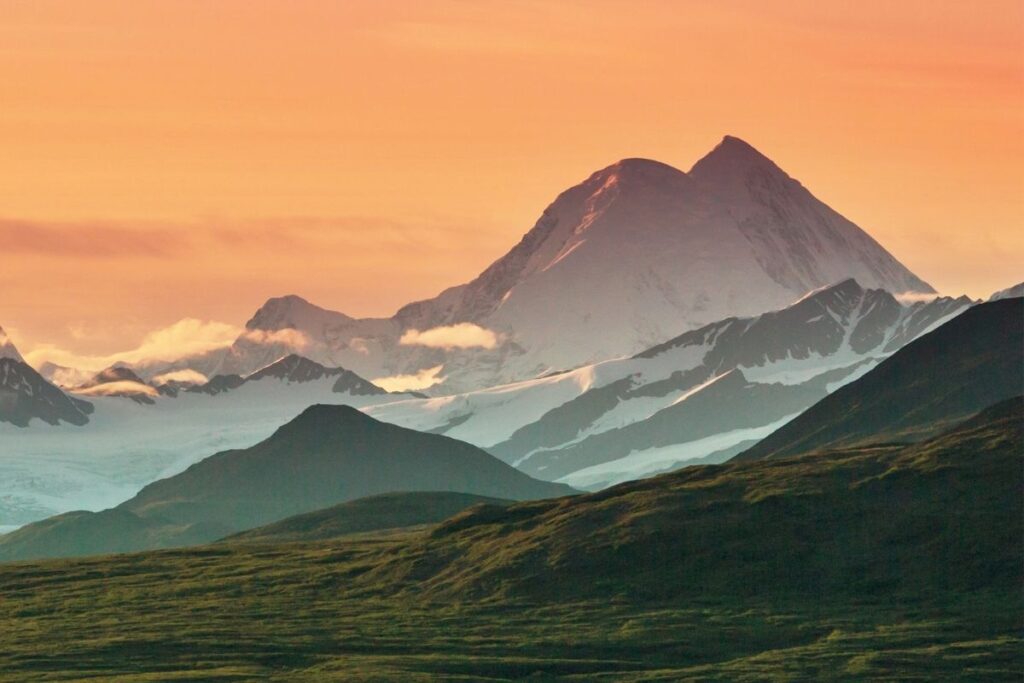
Denali Climbing Facts
Like moths to a flame, tall mountains draw people to them. There is something about standing at the summit that attracts people and Denali is no exception. Man has been documented attempting to climb Denali for over 110 years. Here are some really interesting facts about climbing Denali.
Please note that the Upper Kuskokwim, Koyukon, Dënéndeh, Dena’ina Ełnena, Ahtna Nenn’, and Tanana people lived (and still live in the region) in the flanks and valleys of Denali. It is possible that these local people attempted to climb or successfully climbed the mountain prior to Russian / American exploration of the region. To my knowledge and research, there are no written records or oral history of indigenous people attempting to summit the mountain. If you have knowledge otherwise, please leave me a comment below.
- The first Denali summit attempt was in 1903. Judge James Wickersham and four others attempted to climb the mountain via Peters Glacier and the North Face. They made it to 10,000 ft in elevation before a vertical wall. This wall is known as the “Wickersham Wall” and due to the avalanche dangers wasn’t successfully climbed until 1963 (and has only been climbed a handful of times since 1963).
- In 1906, Dr. Frederick Cook and Ed Barrill claimed to have summited Denali after a failed attempt in 1903. They produced a photograph of Cook on the summit. There were some doubts about their summit but nothing but small talk until 1909. Barrill was paid by another explorer who was looking to discredit Cook to say their 1906 summit was fake. In 1956, Bradford Washburn and Walter Gonnason followed Cook’s route. They identified the locations of Cook’s photos as well as inconsistencies in the account as well as a rocky outcrop near Ruth Glacier that looked a lot like the summit photo. In 1998, historian Robert Bryce found an un-cropped version that definitively confirmed Washburn and Gonnason’s findings.
- The first verifiable Denali summit was on June 7, 1913, by Hudson Stuck, Harry Karstens, Walter Harper, and Robert Tatum. They approached the peak via Muldrow Glacier and McGonagall pass.
- From 1903 to 2019, 46,665 people attempted to summit Denali. Only half (52%) successfully reached the summit.
- Since 2000, about 1,200 people attempt to summit annually. The success rate has varied yearly from 36% to 68%. But the average sits around 54%.
- In 2019, 1,224 climbers attempted to summit Denali with a 64% success rate on summiting. 60% of climbers were from the United States. These climbers were from 43 states plus D.C and US Virgin Islands. Climbers from 50 different nations attempted to climb including Canada, Poland, and Japan. 16% of climbers were women and they had a 52% success rate.
- The most popular month to summit is June and the average climb takes 15-18 days.
>> Read more about Denali’s Climbing history with Jonathan Waterman’s In the Shadow of Denali: Life And Death On Alaska’s Mt. Mckinley
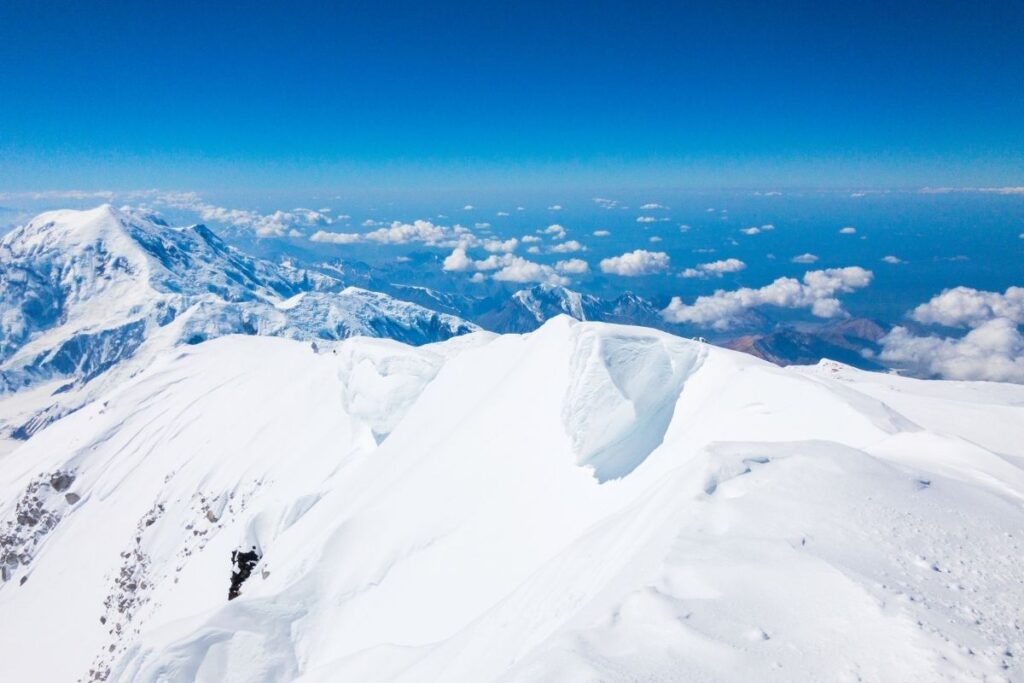
Facts about Denali’s Name
Denali’s name has a tangled and strange history. To locals, the mountain has only ever had one name. It took way longer than it should have to get the name changed back to its historic name.
- Denali’s name comes from Koyukon Athabascan. The Koyukon called the mountain “Deenaalee.” The English translation varies from “The Great One,” “Big Mountain” or “The High One.” No matter the translation, the various native name for Denali all pay reverence to this special mountain.
- Other native language names for Denali include
- Lower Tanana language – Deenadheet, Deenadhee
- Middle Tanana language – Diineezi
- Upper Kuskokwim language – Denaze
- Deg Xinag language – Dengadh, Dengadhi
- Holikachuk language – Denadhe
- Ahtna language – Dghelaay Ce’e, Deghilaay Ce’e
- Upper Inlet Dena’ina language – Dghelay Ka’a
- Lower Inlet Dena’ina language – Dghili Ka’a
>> Learn more about the oral history of the Alaskan Indigenous People in their own words with Shem Pete’s Alaska: The Territory of the Upper Cook Inlet Dena’ina
- Who needs political yard signs to put up political yard signs, when you can name a mountain after your favorite presidential candidate. Gold prospector William Dickey did that.. The 1896 Presidential Election was really important to Dickey. Former Ohio governor William McKinley supported the gold standard and his opponent did not. As a gold miner, Dickey’s income was tied to the gold standard. So he decided to show his support for McKinley by calling the mountain Mount McKinley and writing newspaper articles calling the mountain that. After McKinley was assassinated, the mountain was “officially” named Mount McKinley.
- As Mount McKinley, the mountain was named after an Ohio-born President who had never been to Alaska and didn’t sign any significant legislation about Alaska while President.
- In the mid-1970s, Alaska started trying to change the mountain’s official name back to Denali. They were blocked by Ohio Congressman Ralph Regula. Regula’s congressional district included McKinley’s hometown. Regula used procedural maneuvers to prevent the United States Board on Geographic Names from renaming the mountain.
- In 2015, United States Secretary of the Interior Sally Jewell changed the official name back to Denali. Ohio Representative objected and signed a letter of complaint stating that “William McKinley’s legacy has been tarnished by a political stunt.” They seriously wrote that about returning the mountain to her historic name.
There’s a lot of things in Ohio that are already named after McKinley. This is no affront to our former president; this is all about ensuring that respect for the land and respect for the native people of the region is afforded.
Alaskan Senator Lisa Murkowski’s response to the Ohio whinny letter of complaint about changing the back to Denali.
You may still see signs and maps referring to the mountain as Mount McKinley. It is a slow process to re-do everything and in a few more years everything should be switched over.
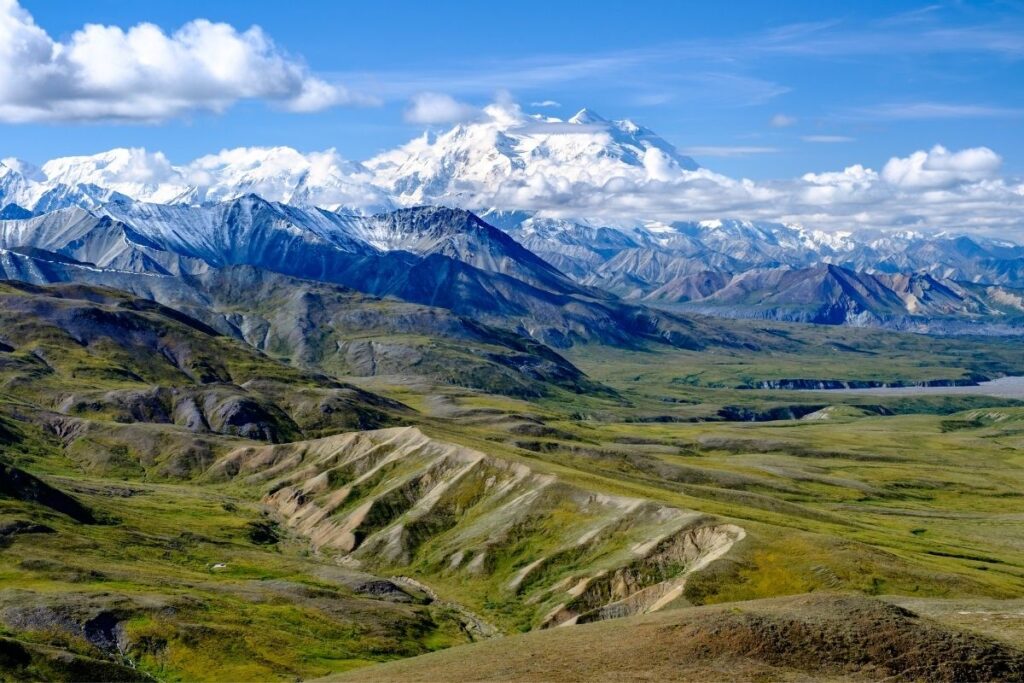
Denali National Park Facts
Denali National Park has a fascinating history and there are a lot of fun things to know about Denali National Park.
- Denali National Park was the first National Park in Alaska.
- It was established as Mount McKinley National Park on February 26, 1917.
- Mount McKinley National Park was originally established to protect the Dall Sheep.
- In 1976, the park was designated an International Biosphere Reserve.
- The Alaska Native Interests Land Conservation Act in 1980 established Denali National Park and Preserve and expanded tripled the size of the park and added the National Preserve as a unit of the National Park Service.
- Denali National Park and Preserve is actually two National Park Service units that are managed as a single unit.
- Denali National Park and Preserve is 6,045,153 acres or 9,446 sq miles (24,464 sq km). The National Park unit is 4.74 million acres. The National Preserve is 1.3 million acres.
- Over 600,000 people visited Denali National Park in 2019.
- There are 92 miles of road in Denali. That is 65,708 acres per mile of road in the park.
- The lowest point in Denali National Park is the Yentna River which is 240 ft (73 m) above sea level.
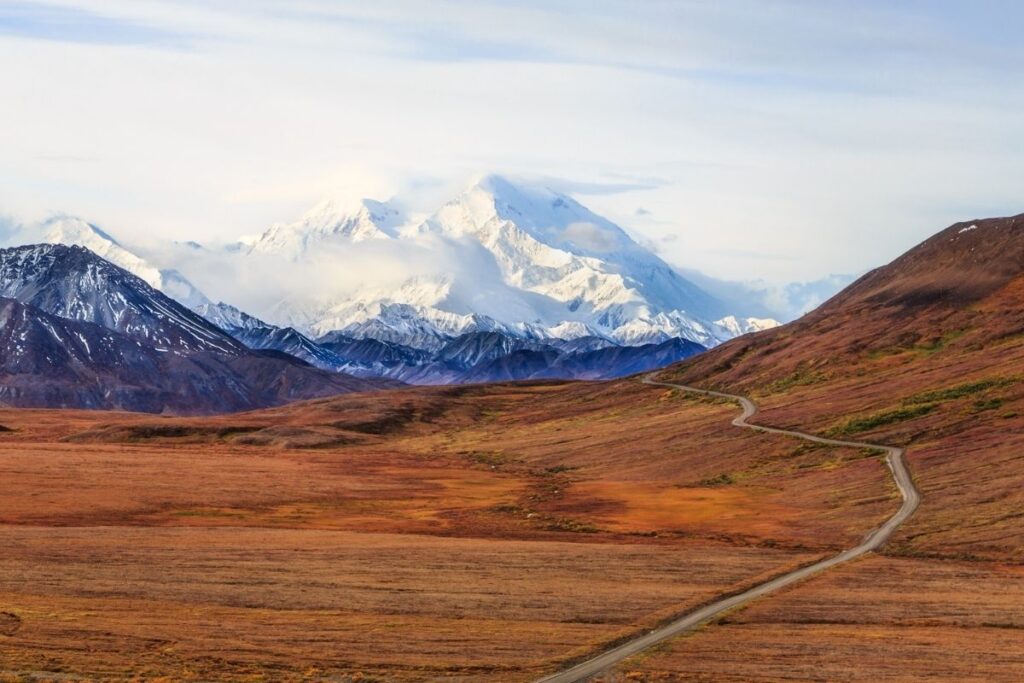
Denali Wildlife Facts
- Denali National Park has 39 species of mammals including Moose, Caribou, Dall Sheep, Wolves, and Grizzly Bears.
- There are 169 species of birds including a range of migratory species such as the Arctic Tern. The Arctic Tern makes a 12,000-mile (19,000 km) migration from its wintering grounds in northern Antarctic to Alaska for the breeding season.
- In Denali, there are 14 species of fish, 758 species of plants, 600+ species of moss and lichen, and 8 species of trees.
- There is one species of amphibian in the park. The wood frog is one of the coolest animals in the world. During the winter, the frog goes into a cryogenic state when freezes almost solid and its body completely shuts down. In the spring, the frog thaws out and hops away.
- In 2016, paleontologists found the first dinosaur bones during an expedition in Denali National Park and Preserve. The previous expedition had since the discovery of dinosaur tracks in the Cantwell Formation near Igloo Creek.
- While Woolly Mammoth remains have been found around Alaskan there was no evidence of the animals in Denali until a visitor found a tooth in the 1960s. There was no further evidence until 2018 when the first Woolly Mammoth tusk was found inside the park.

Final Thoughts on these Facts about Denali National Park and Denali?
I hope you have learned something from these Denali facts and statistics. You should be ready to clean house at national park trivia night.
Do you have any questions about Denali Denali Park or need help planning your National Park trips. Let me know in the comments or join me in my National Park Trip Planning Community!
More Information for your trip to Alaska
- ALASKA: National Parks of Alaska
- ALASKA NATIONAL PARK: How much does it cost to visit Alaska’s National Parks?
- DENALI: Visiting Denali National Park and Preserve: The Complete Guide
- 11 Things to Know Before Visiting Denali National Park and Preserve
- 8 Books to Read Before visiting Denali National Park
- Denali National Park Camping: The Definitive Guide to Camping in Denali National Park
- Where to Stay in Denali National Park? 14 Best Denali Hotels
- The 20 ABSOLUTE Best Hikes in Denali National Park
- 25 Amazing Denali National Park Tours
- Denali Road Lottery – Everything You Need to Know
- GLACIER BAY: Visiting Glacier Bay National Park and Preserve: The Complete Guide
- KATMAI: Visiting Katmai National Park and Preserve: The Complete Guide
- FAIRBANKS: Chena Hot Springs Resort – The best way to end your Alaska Adventure
- WRANGELL – ST. ELIAS: Visiting Wrangell – St. Elias National Park and Preserve: The Complete Guide

Does Alaska Trip Planning Leave You Feeling Overwhelmed?
Jump right into booking your Alaska National Parks trip with our expertly designed, pre-made, downloadable National Park itineraries.
Pin for Later: 35+ Extraordinary Denali Facts & Statistics

Jennifer Melroy
Hi, I'm Jennifer!

Welcome to the wonderful world of National Parks. I'm here to help you plan your NEXT amazing adventure through the United States National Parks and beyond. I want the national parks to be accessible to all.
I live in Tennessee, and when I'm home, you can find me hiking in the Smokies and the Cumberland Plateau.
58/63 National Parks
250+/423 National Park Units
Want to know more? Start Here.
ACKNOWLEDGEMENT OF LAND
On this site, we promote travel to the United States and beyond that are the traditional lands of Indigenous and First Nations peoples.
With respect, I make a formal land acknowledgment, extending my appreciation and respect to these lands’ past and present people.
To learn more about the people who call these lands home, I invite you to explore Native Land.
DISCLAIMER
National Park Obsessed assumes no responsibility or liability for any errors or omissions in the content of this site (NationalParkObsessed.com). The information contained in this site is provided with no guarantees of completeness, accuracy, usefulness or timeliness. You are encouraged to conduct your own due diligence before acting on the information provided on this site and should not rely on the opinions expressed here.
There is an inherent risk in all outdoor recreation activities, the reader assumes all responsibility for their own personal safety.
DISCLOSURE
We are a participant in the Amazon Services LLC Associates Program, an affiliate program designed to provide a means for us to earn fees by linking to Amazon.com and affiliated sites.
Privacy Policy • About Us • Contact
Select stock photography provided depositphotos
Copyright ©2023 National Park Obsessed, LLC
Last Updated on 18 Jun 2022 by Jennifer Melroy



